NCERT Based Activity: Mindful Eating: A Path to a Healthy Body | Science for Class 6 PDF Download
Activity 3.1: Let us record
All of us eat food every day. Food is an essential component of our daily life. List the food items you have consumed over the week in Table 3.1.
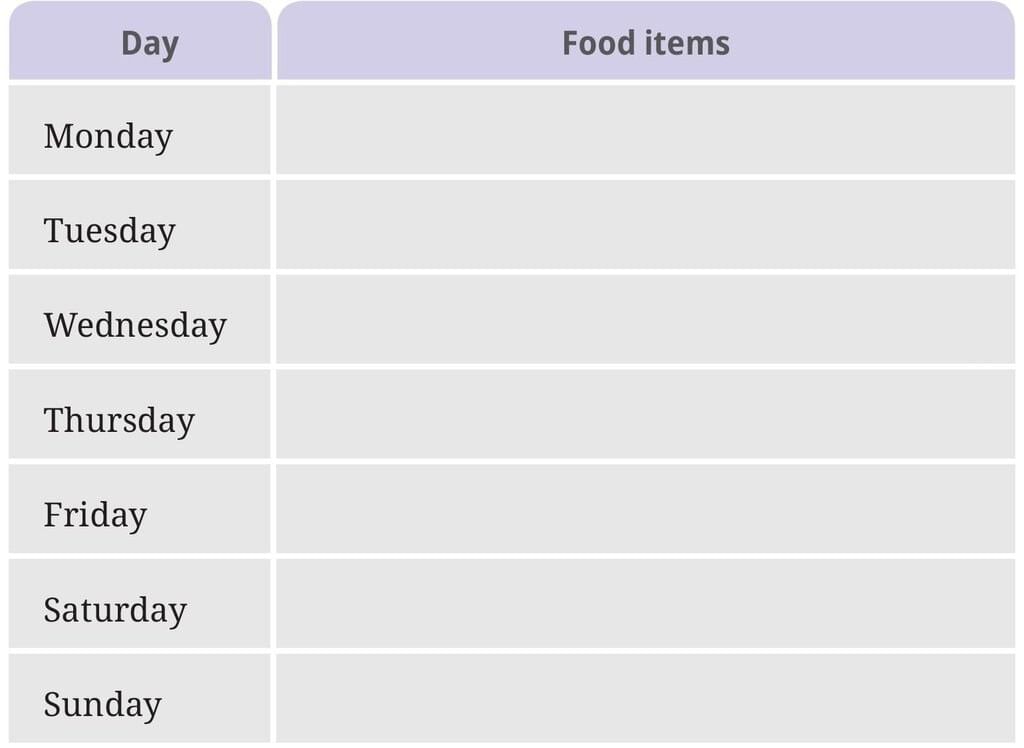 Table 3.1: Food items consumed over a week
Table 3.1: Food items consumed over a week
What observations can you make about your food from the data collected in Table 3.1? Do you eat the same kind of food in every meal or do your choices vary? Compare your list with those prepared by your friends.
Find similarities and differences in the food consumed by you and your friends. What did you find? Record your findings in your notebook. You may have noticed that there is a variety in the food eaten by you and your friends. Do you think that such diversity in food exists in all states of our country?
Ans: Food items consumed over the week as follows:
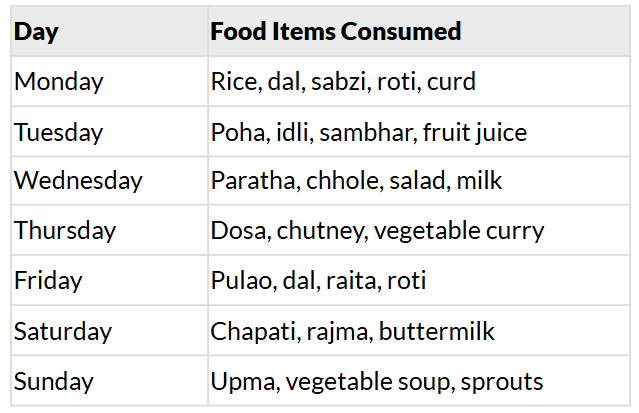
Observations from the given food chart:
- Variety in Food Choices: The food items consumed vary each day. Different types of grains, vegetables, and dairy products are included in the meals.
- Balanced Diet: The meals consist of carbohydrates (rice, roti, chapati, pulao), proteins (dal, chhole, sprouts, rajma), vitamins and minerals (vegetables, salad, fruit juice), and dairy products (milk, curd, buttermilk).
- Regional Influence: Some dishes, such as dosa, idli, sambhar, and poha, are commonly associated with South Indian cuisine, while chhole, rajma, and paratha are more common in North India.
- Diversity in Meals: There is no repetition of the same food every day, ensuring variety in taste and nutrition.
Comparison with Friends’ Food Habits:
- Similarities: Many friends might also consume rice, dal, roti, vegetables, and dairy products in their meals.
- Differences: Some may have different dishes based on their regional background or personal preferences, such as different types of bread (naan, bhakri) or different styles of curries and dals.
Diversity in Food Across India:
Yes, there is significant diversity in food habits across different states in India. This is due to differences in climate, locally available ingredients, cultural traditions, and historical influences. For example:
- North India: Wheat-based foods like chapati, paratha, and naan are common.
- South India: Rice-based dishes like dosa, idli, and sambhar are popular.
- East India: Fish, rice, and mustard-based curries are commonly eaten.
- West India: A mix of spicy curries, thepla, dhokla, and seafood is prevalent.
This diversity makes Indian cuisine rich and unique.
Activity 3.2: Let us explore
Find out the types of food traditionally consumed and the crops grown in various states of India. You may refer to books in your library, search the internet, and interact with your friends, family and neighbours to collect information.
In Table 3.2, add more states and fill the collected data. A few examples are already given.
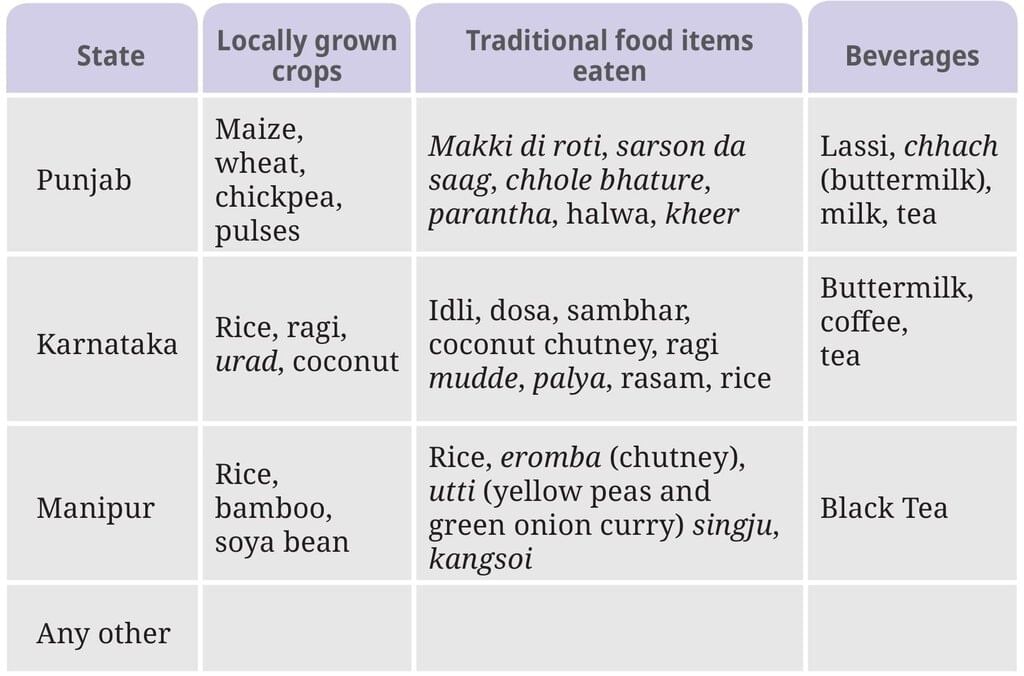 Table 3.2: Some traditional food items in various states of India
Table 3.2: Some traditional food items in various states of India
Why do we see diversity in traditional food consumed in various states of our country?
Ans: Table as follows: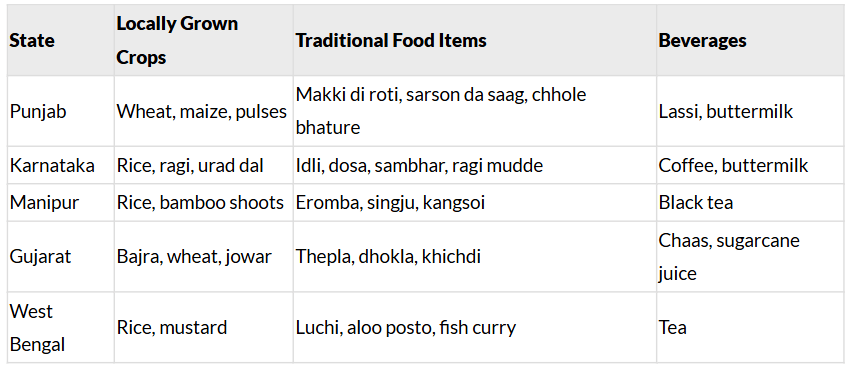 The diversity in traditional food across Indian states is due to:
The diversity in traditional food across Indian states is due to:
- Climate & Geography – Availability of crops varies (rice in the South, wheat in the North).
- Local Ingredients – Coastal areas eat seafood, while hilly regions prefer dairy and root vegetables.
- Cultural & Historical Influence – Mughal, Portuguese, and regional traditions shape food habits.
- Religious & Social Practices – Some communities follow vegetarianism, while others eat non-vegetarian food.
- Cooking Methods & Spices – Each state has unique cooking styles and spice preferences.
Activity 3.3: Let us interact and find out
Prepare a list of questions for gathering information from elderly people about their food habits and cooking practices. Following are some of the sample questions—
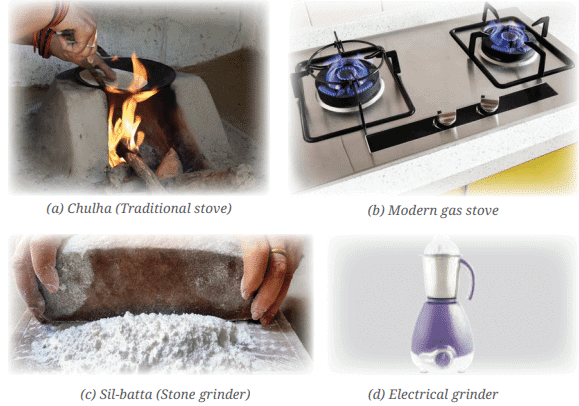 Fig. 3.1: Changes in cooking tools over time
Fig. 3.1: Changes in cooking tools over time
Interview Questions and Findings:
What kind of food do you still eat and what is new?
- Elderly people still eat dal, roti, rice, and vegetables.
- New foods include fast food, packaged snacks, and soft drinks.
What are the changes in cooking practices over time?
- Earlier, people used chulha (wood stove) and sil-batta (stone grinder).
- Now, they use gas stoves, mixers, and electric cookers.
What has caused these changes?
- Technology: Gas stoves, refrigerators, and blenders make cooking easier.
- Urbanisation: Less time for cooking leads to more processed food.
Conclusion:
- Cooking methods have evolved due to technology and convenience.
- Traditional cooking was healthier but required more effort.
Activity 3.4: Let us conduct a survey
Study the chart given in Fig. 3.5 to explore the functions and sources of various food components. Find out more sources of vitamins and minerals. Also, understand the symptoms of the diseases caused by the lack of these food components. Visit your neighbourhood, interact with people and find out if any individual shows the symptoms listed on the chart (an investigatory project of this kind can be taken by the students under the guidance of a teacher).
Correlate these symptoms with their diet and identify the deficiency disease(s) or disorder(s). Suggest the possible cause(s) for the symptoms observed and changes required in the diet for improvement. Suggest them to visit a doctor for further advice.
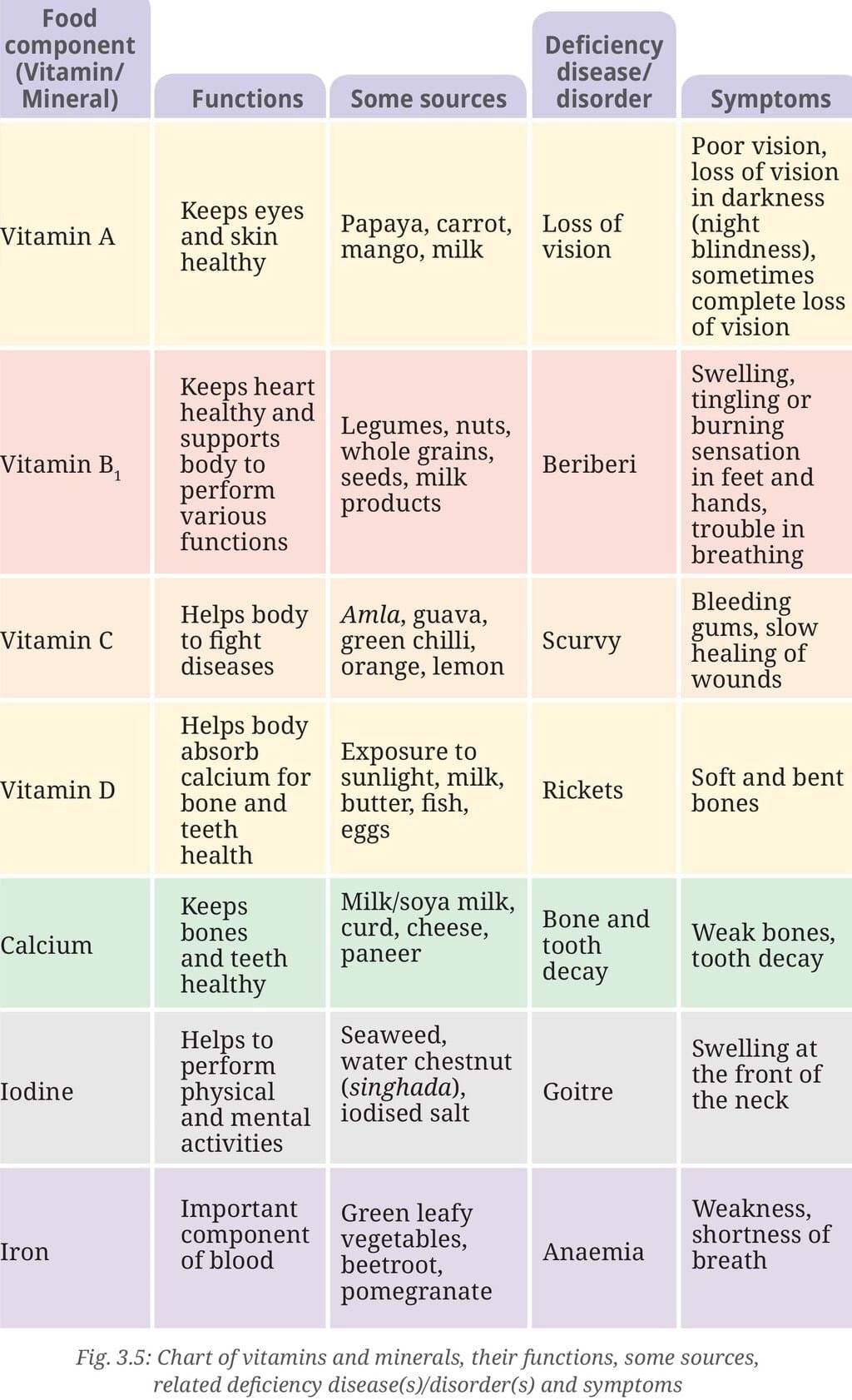
Ans:
Survey Observations:
- Vitamin C deficiency (Scurvy): People with a poor diet had bleeding gums.
- Iodine deficiency (Goitre): Some older adults had thyroid swelling.
- Calcium deficiency (Rickets): Some children had weak bones.
Suggestions:
- Eat fruits, vegetables, and dairy products.
- Use iodised salt.
- Drink milk for calcium.
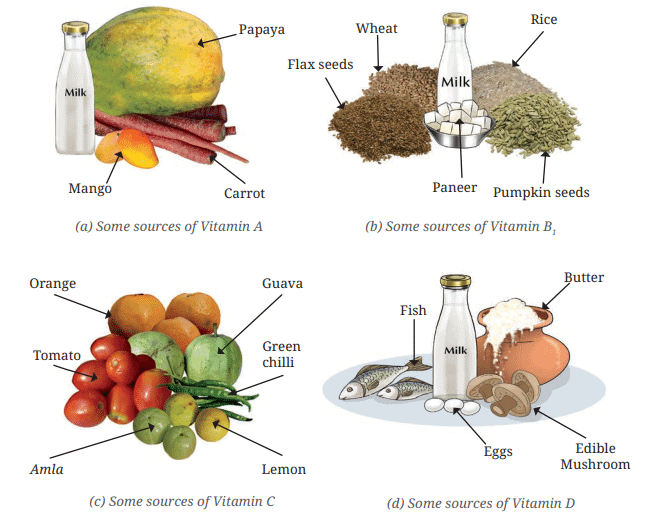 Some Sources of Vitamins
Some Sources of Vitamins
Q: From Fig. 3.5, you have learnt that vitamins (A, B1, C and D) and minerals (calcium, iodine, and iron) are two groups of food components that protect our body from various diseases. But, how can we overcome vitamin and mineral deficiency diseases or disorders?
Ans: To overcome vitamin and mineral deficiency diseases, follow these steps:
- Eat a Balanced Diet – Include a variety of fruits, vegetables, whole grains, dairy, and proteins.
- Consume Vitamin-Rich Foods–
- Vitamin A: Carrots, spinach, sweet potatoes.
- Vitamin B: Whole grains, eggs, dairy, green leafy vegetables.
- Vitamin C: Citrus fruits, tomatoes, bell peppers.
- Vitamin D: Sunlight, fish, fortified dairy products.
- Increase Mineral Intake–
- Iron: Green leafy vegetables, nuts, red meat.
- Calcium: Milk, cheese, yoghurt, ragi.
- Iodine: Iodised salt, seafood.
- Avoid Junk Food – Processed foods lack essential vitamins and minerals.
- Take Supplements (if needed) – Consult a doctor for vitamin or mineral supplements if dietary intake is insufficient.
- Regular Health Check-ups – Monitor nutrient levels and take corrective measures if deficiencies are detected.
- Drink Enough Water – Helps in nutrient absorption and overall health.
A well-balanced diet and healthy lifestyle can prevent vitamin and mineral deficiencies.
Activity 3.5: Let us investigate
Take a small quantity of the food items such as a slice of potato, cucumber, bread, some boiled rice, boiled gram, crushed peanuts, oil, butter and crushed coconut. You can take other food items too for testing.
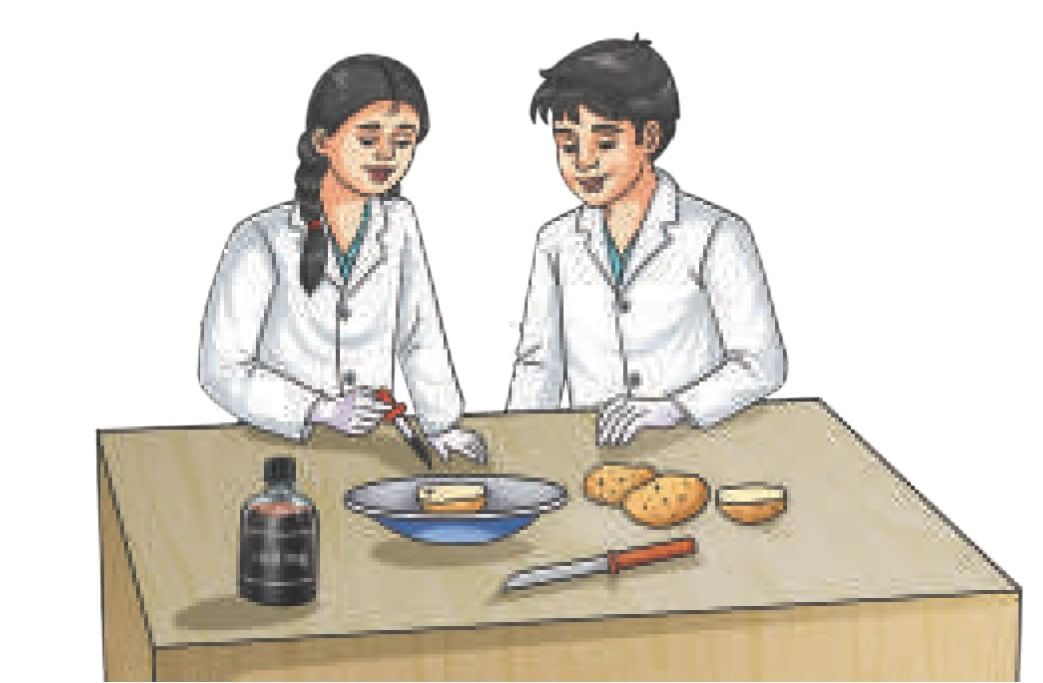 Fig. 3.7: Testing for the presence of starch in various food items
Fig. 3.7: Testing for the presence of starch in various food items
- Place a small piece of each item on a separate dish.
- With the help of a dropper, put 2–3 drops of diluted iodine solution on each food item (Fig. 3.7).
- Observe if there are any changes in the colour of the food items. Have they turned blue-black? Record your observations in Table 3.3.
Ans: A blue-black colour indicates the presence of starch.
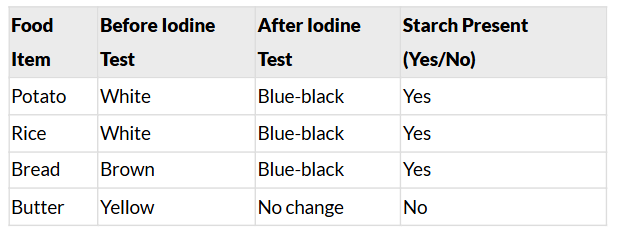
Conclusion:
- Starch is present in potatoes, rice, and bread.
- Fats like butter do not contain starch.
Activity 3.6: Let us investigate
Take a small part of the food items that you tested for the presence of starch in Activity 3.5.
Place each food item on a separate piece of paper.
Wrap the paper around the food and press it. Be careful not to tear the paper.
If a food item contains a little water, allow the paper to dry.
Does the paper develop an oily patch? What do you think is the reason for this patch? If oil or butter is present in the food item, it leaves an oily patch on the paper. Now, hold the paper against the light. Can you see the light faintly shining through this patch? An oily patch on the paper shows that the food item contains fat. Which of these items contains fats? Record your observations in Table 3.3.
Ans: Observations from Activity 3.5
- When a food item is pressed between paper, an oily patch appears if it contains fat.
- The oily patch allows light to pass through when held up against light.
- This confirms the presence of fats in the food item.
Possible food items that may leave an oily patch (contain fats):
- Butter
- Ghee
- Nuts (almonds, peanuts, cashews)
- Cheese
- Fried foods (samosa, chips, pakoras)
- Oil-based foods (mayonnaise, salad dressing)
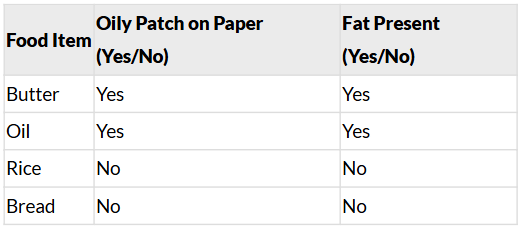 Your observations in Table 3.3 indicate that:
Your observations in Table 3.3 indicate that:
- Butter and Oil contain fat, as they leave an oily patch on paper.
- Rice and Bread do not contain fat, as they do not leave an oily patch.
This simple test helps identify the presence of fats in different food items.
Activity 3.7: Let us investigate
This activity may be demonstrated by the teacher.
- Take the food items tested in previous activities.
- Make a paste or powder of the food item using pestle and mortar (Fig. 3.8).
- Put about half a teaspoon of each food item in a separate clean test tube.
- Add 2–3 teaspoons of water to each test tube and shake them well.
- Add two drops of copper sulphate solution to each test tube using a dropper.
- Now, take another dropper and add 10 drops of caustic soda solution to each tube (Fig. 3.8).
- Shake well and leave the test tubes undisturbed for a few minutes.
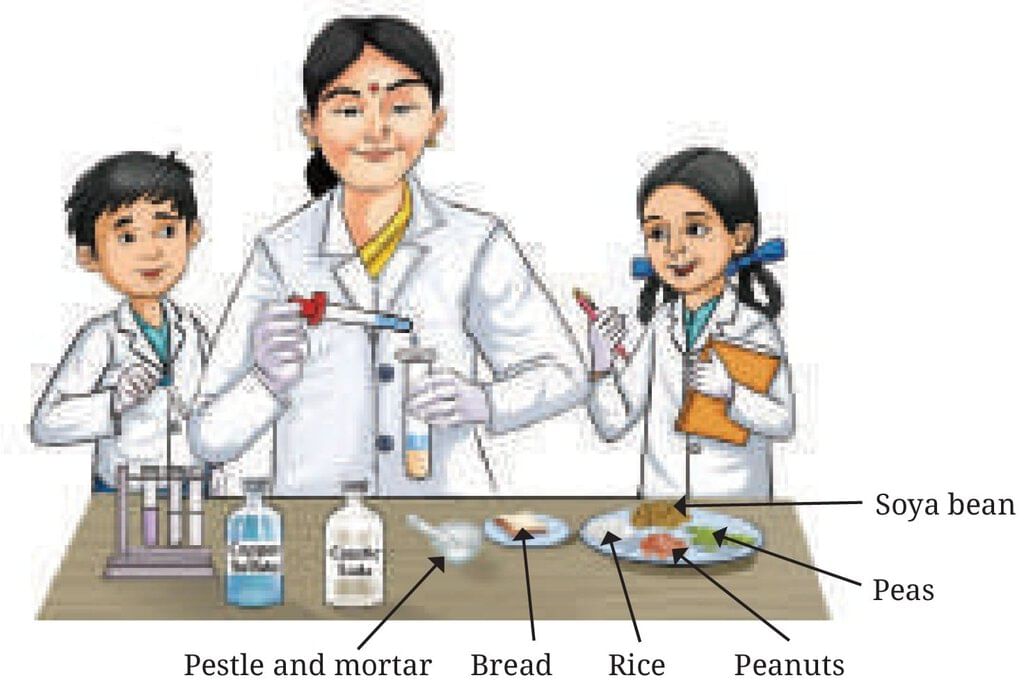 Testing for the presence of protein in various food items
Testing for the presence of protein in various food items
What did you observe? Did the content of some test tubes turn violet? This violet colour indicates the presence of proteins in the food item. Write your observations in Table 3.3.
What conclusions can you draw from Table 3.3? Which food items show the presence of more than one nutrient? Which food items show the presence of both proteins and fats? Peanuts show the presence of both proteins and fats. This indicates that any food which we eat may contain multiple nutrients. Is there a food item that lacks any of these nutrients? Which of these foods do you consume daily? Try to find out other foods that are good sources of starch, fats, and proteins.
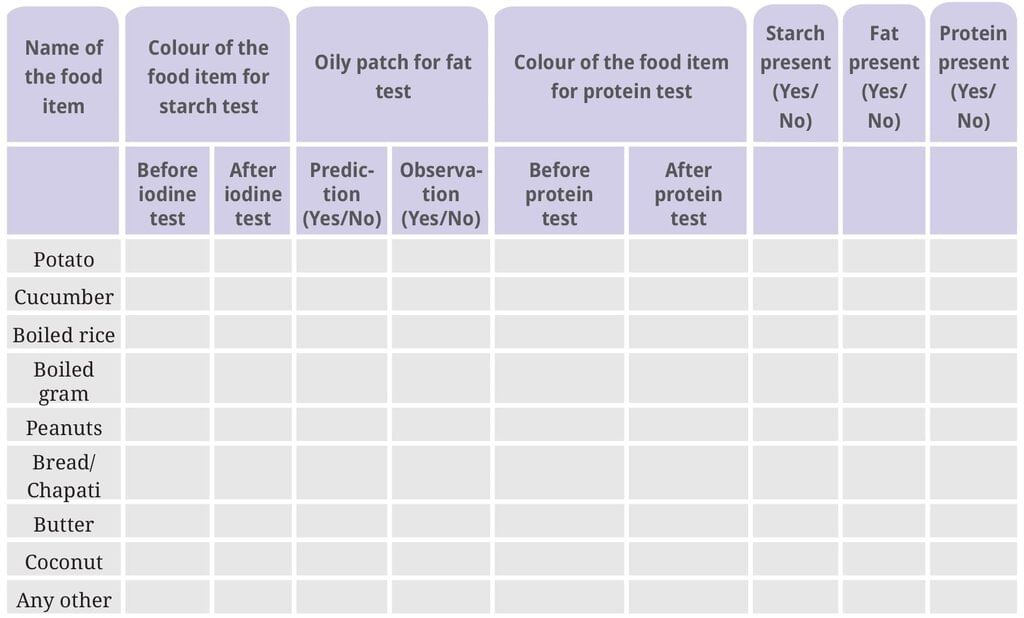 Exploring nutrients present in various food items
Exploring nutrients present in various food items
Ans: Results for starch, fat, and protein tests for the given food items: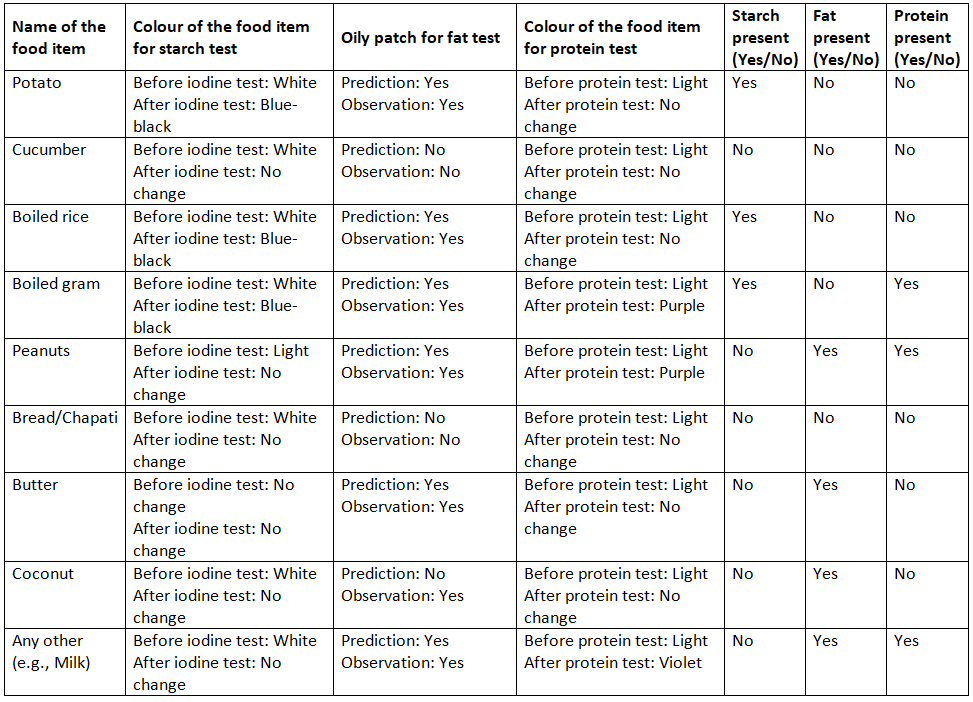
Activity 3.8: Let us find out
You have listed food consumed by you during the week in Activity 3.1. Check whether your food contains all the nutrients and other essential components necessary for growth and development. If not, check which nutrients or other food components need to be added.
A diet that has all essential nutrients, roughage, and water in the right amount for proper growth and development of the body is known as a balanced diet. What changes would you make in your diet to make it a balanced diet?
Ans: Checking Nutrient Presence in the Diet:
- Carbohydrates (Energy-giving foods): Rice, roti, poha, paratha, dosa, pulao, chapati.
- Proteins (Body-building foods): Dal, chhole, rajma, sprouts, sambhar.
- Fats (Energy reserve): Ghee, butter, oil (used in cooking), fried foods.
- Vitamins & Minerals (Protective foods): Vegetables, salad, fruit juice, vegetable soup.
- Roughage (Fibre): Salad, vegetables, fruits, whole grains.
- Water: Present in soups, juices, and consumed directly.
Changes to Make the Diet More Balanced:
- Increase Protein Intake – Add eggs, paneer, soybeans, or fish for better muscle growth.
- Include More Fruits – Eat a variety of seasonal fruits for essential vitamins and minerals.
- Add Nuts & Seeds – Almonds, walnuts, flaxseeds for healthy fats and proteins.
- Ensure Enough Water Intake – Drink at least 8-10 glasses of water daily.
- Reduce Excess Oil & Sugar – Avoid fried and sugary foods for a healthier balance.
By making these small changes, the diet can become more balanced, ensuring proper growth and development.
Activity 3.9: Let us compare
Read the nutritional information given below for a packet of potato wafers and a packet of roasted chana shown here.
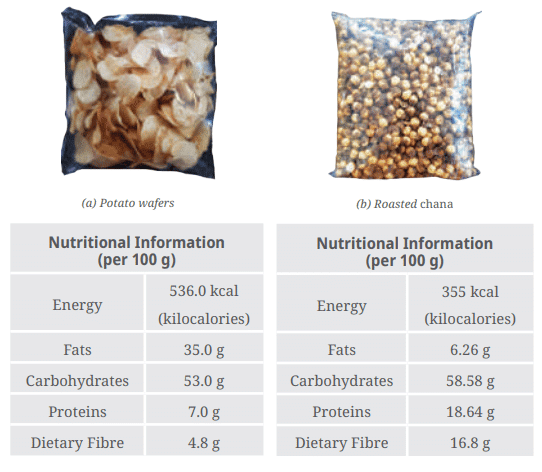
Based on the nutritional information on the food packets given above, which food would you choose? Why?
Ans: I would choose Roasted Chana for the following reasons:
- Higher protein content: Roasted chana contains 18.64g of protein per 100g, which is significantly higher than the 7.0g in potato wafers. Protein is important for muscle building and overall health.
- Lower fat content: Roasted chana has only 6.26g of fat compared to 35.0g in potato wafers, making it a healthier option for those looking to control fat intake.
- Higher dietary fibre: Roasted chana also provides more dietary fibre (16.8g) compared to potato wafers (4.8g), which helps in digestion and maintaining gut health.
- Lower energy content: Roasted chana has fewer calories (355 kcal) compared to potato wafers (536 kcal), making it a better option for those watching their calorie intake.
So, Roasted Chana offers more nutritional value in terms of protein, fibre, and lower fat, making it a healthier choice overall.
Q: Which of the two foods you studied in Activity 3.9 could be labelled as junk food?
Ans: Potato Wafers could be labelled as junk food because it is high in fats (35.0g) and calories (536 kcal), with lower protein and fibre content. These characteristics make it less nutritious and higher in unhealthy fats and calories compared to the healthier option of roasted chana.
|
67 videos|289 docs|27 tests
|
FAQs on NCERT Based Activity: Mindful Eating: A Path to a Healthy Body - Science for Class 6
| 1. What is mindful eating and how can it contribute to a healthy body? |  |
| 2. How can I test for starch in food? |  |
| 3. What are the differences between healthy food and junk food? |  |
| 4. What are food miles and why are they important? |  |
| 5. How can I maintain a balanced diet? |  |






















